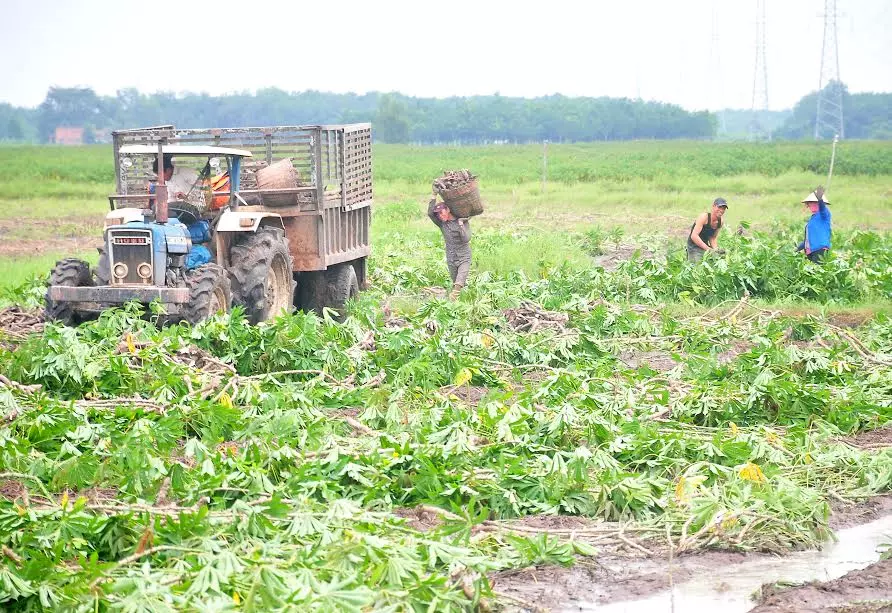Export of cassava and cassava products reached over 1 billion USD, China is still the main consumer market. In the first 10 months of 2023, the export of cassava and cassava products will reach over 2.39 million tons, worth 1.02 billion USD, down 6.4% in volume and down 8.8% in turnover compared to the same period last year. period of 2022. China is still the market accounting for 90.01% in volume and 91.49% in value of Vietnam’s total export of cassava products…
According to the General Department of Customs, in October 2023, Vietnam’s export of cassava and cassava products reached 268.37 thousand tons, with a value of 136.49 million USD, an increase of 2.1% in volume and an increase of 11,000 USD. 1% in value compared to September 2023 and compared to the same period in 2022, an increase of 12.6% in volume and an increase of 33% in value.

In October 2023, the average export price of cassava and cassava products is at 508.6 USD/ton, up 8.8% compared to September 2023 and up 18.1% compared to October 2022. .
China accounts for 90% of Vietnam’s cassava starch export market share
In October 2023, China is still Vietnam’s largest export market for cassava and cassava products, accounting for 90.01% in volume and 91.49% in value of total cassava and cassava exports. The country’s cassava products reached 241.55 thousand tons, worth 124.88 million USD, down 4.7% in volume, but up 6.2% in value compared to September 2023; Compared to October 2022, it increased by 16.6% in volume and 40.2% in value.
In the 10 months of 2023, the export of cassava and cassava products will reach over 2.39 million tons, worth 1.02 billion USD; down 6.4% in volume and 8.8% in value compared to the same period in 2022.
According to the Vietnam Cassava Association, although the total amount of cassava exports decreased, the export of cassava and cassava products to some markets still grew well in both volume and value compared to the same period in 2022, such as the market Taiwan, Malaysia, Japan, EU market. Of which, exports to China were 2.18 million tons of cassava and cassava products, worth 929.57 million USD, down 6.2% in volume and 9.3% in value over the same period last year. 2022.
The Vietnam Cassava Association said that currently Vietnamese factories are offering cassava starch at prices ranging from 535-550 USD/ton FOB delivered at Ho Chi Minh City port. The price of cassava starch delivered in Mong Cai and Lang Son fluctuates at 4,100 – 4,350 CNY (Yuan)/ton. Meanwhile, the export price of cassava chips to the Chinese market is about 295 USD/ton FOB at Quy Nhon port; The export price to the Korean market is about 335 USD/ton FOB at Quy Nhon port.
According to an announcement from China, the country will apply the policy of importing border residents from November 1, 2023. Accordingly, goods that are not processed locally such as cassava flour, dried tea leaves, cashew nuts and other dry goods will not be subject to direct customs clearance regulations “including imported vehicles, “The whole vehicle is exported” as in recent times, but the regulation on loading and unloading to the vehicle is restored.
Notably, the pick-up fee at the border gate area on the Chinese side increased by about 100 CNY/ton for loading and unloading costs, transit vehicles, taxes and other fees. Thus, each truck of goods exported through the border gate will cost a total of 8,000 CNY.
Regarding domestic cassava supply, the Vietnam Cassava Association informed that this year, prolonged heavy rains in the Southeast provinces and Cambodia have made the quality of cassava harvested worse than usual. It is expected that the supply of cassava chips when entering the upcoming December production season will decrease, due to the forecast that the source of fresh cassava roots will decrease sharply.
It is forecasted that in the 2023/24 crop year, units trading in this product may have to increase the import of cassava chips from Laos and Cambodia to Vietnam to meet the needs of domestic animal feed factories, as well as for export.
The cassava industry sets an export target of 2 billion USD in 2028
Tay Ninh is the leading locality in the number of cassava processing factories in the country. Currently in this province there are 65 cassava processing factories with a total capacity of 6.4 million tons of tubers/year.
Mr. Nguyen Dinh Xuan, Director of the Department of Agriculture and Rural Development of Tay Ninh province, said that Tay Ninh is currently the capital of the cassava industry in the country, more than 50% of annual cassava export turnover belongs to Tay Ninh enterprises. .
However, Tay Ninh’s growing area is not large, the whole province currently has about 62 thousand hectares, with a productivity of about 2 million tons/year, only meeting 50% of raw materials for the local cassava processing industry. To have enough raw materials, businesses purchase cassava from neighboring provinces and neighboring Cambodian provinces.
According to Mr. Xuan, Tay Ninh cassava industry is still limited as there is no link in investment in purchasing raw materials between processing factories and farmers, and no regional linkage policy mechanism has been formed to attract investment. long term settlement. In order for Tay Ninh’s cassava to grow stably and truly sustainably, it is necessary to reorganize production towards building large production areas. This is the basis for linking with businesses to reduce intermediaries and create opportunities to upgrade the product value chain.
Ms. Vo Thi Linh Phuong, Director of Tay Ninh Tapioca Joint Stock Company (Tay Ninh Tapioca JSC) said that most factories have increased capacity. However, because local cassava sources cannot keep up with processing, there has been a situation of competition for buying and selling, leading to unfair competition, pushing input materials up, while output remains unchanged. causing many businesses to struggle. Only the enterprise that can master the raw material area will win.
According to the Vietnam Cassava Association, the country’s cassava growing area is currently about 530,000 hectares, with a total output of over 10 million tons/year. Mr. Nghiem Minh Tien, Chairman of the Vietnam Cassava Association, commented that in the past 10 years, Vietnam’s cassava industry has developed rapidly. The export turnover of cassava and cassava products increases from 0.958 billion USD in 2018 to nearly 1.5 billion USD in 2022. Vietnam currently ranks 2nd in the world in cassava, after Thailand.
The Vietnam Cassava Association has set a target for cassava exports to reach 2 billion USD/year by 2028 and increase to 2.5 billion USD/year by 2050.
To achieve this number, Mr. Nghiem Minh Tien said that the cassava industry needs to address three current weaknesses. That is: Export depends too much on one market; Processing technology is still outdated, there are not many deeply processed products; imbalance between processing and raw cassava growing areas…
“In order for the cassava industry to develop stably, sustainably and with quality, Vietnam needs to restructure the domestic cassava industry; Ensure balance of raw materials in production. At the same time, build a linked cassava variety development center to create new seed sources to promptly meet the seed needs of farmers; ensure fairness of credit and tax policies; diversify export markets; Encourage and empower businesses to invest in environmental treatment and in-depth production and processing to enhance the value of starch,” Mr. Nghiem Minh Tien emphasized.
Modified tapioca starch, Tapioca starch
